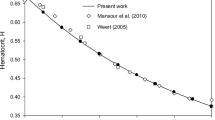Abstract
The blood plasma flow through a swarm of red blood cells in capillaries is modeled as an axisymmetric Stokes flow within inverted prolate spheroidal solid-fluid unitary cells. The solid internal spheroid represents a particle of the swarm, while the external spheroid surrounds the spheroidal particle and contains the analogous amount of fluid that corresponds to the fluid volume fraction of the swarm. Analytical expansions for the components of the flow velocity are obtained by introducing a stream function ψ which satisfies the fourth-order partial differential equation E4ψ = 0. We assume nonslip conditions on the internal inverted spheroidal boundary which is also impermeable, while on the external spheroidal surface, we assume continuity of the tangential velocity component and nil vorticity. In order to solve the problem at hand, we employ the method of Kelvin inversion, under which, the initial problem, formulated in the inverted prolate spheroidal coordinates, is transformed to an equivalent one in the prolate spheroidal coordinates, where the solution space of the equation E4ψ = 0 is already known from our previously published work. The solution for the original problem is obtained by using the inverse Kelvin transformation and the effect of this transform to the Stokes operator (Dassios, IMA J Appl Math 74:427-438, 2009). Finally, the analytical solution for the stream function ψ is given through a series expansion of specific combinations of Gegenbauer functions of mixed order, multiplied by the Euclidean distance on the first and on the third power, in a so-called R-separable form.
Access this chapter
Tax calculation will be finalised at checkout
Purchases are for personal use only
Similar content being viewed by others
References
Dassios G (2009) The Kelvin transformation in potential theory and Stokes flow. IMA J Appl Math 74:427–438
Dassios G, Hadjinicolaou M, Payatakes AC (1994) Generalized Eigenfunctions and complete semiseparable solutions for Stokes flow in spheroidal coordinates. Q Appl Math LII(I):157–191
Dassios G, Hadjinicolaou M, Coutelieris FA, Payatakes AC (1995) Stokes flow in spheroidal particle in cell models with Happel and Kuwabara boundary conditions. Int J Eng Sci 33:1465–1490
Dassios G, Hadjinicolaou M, Protopapas E (2012) Blood plasma flow past a red blood cell: mathematical modelling and analytical treatment. Math Methods Appl Sci 35(13):1.547–1.563
Hadjinicolaou M, Kamvyssas G, Protopapas E (2015) Stokes flow applied to the sedimentation of a red blood cell. Q Appl Math 73:511–523. Online ISSN 1552-4485; Print ISSN 0033-569X, 2013
Happel J, Brenner H (1957) Viscous flow in multiparticle systems: motion of spheres and a fluid in a cylindrical tube. AICHE J 3(4):506–513
Happel J, Brenner H (1991) Low Reynolds number hydrodynamics. Kluwer Academic Publishers, Dordrecht
Kuwabara S (1959a) The forces experienced by random distributed parallel circular cylinders or spheres in a viscous flow at small Reynolds numbers. J Phys Soc Jpn 14(4):527–532
Lebedev NN (1972) Special Functions and Their Applications. Dover Publications
Uchida S, Motai T (1954) Slow viscous flow through a mass of particles. Ind Eng Chem 46(6):1194–1195
Author information
Authors and Affiliations
Corresponding author
Editor information
Editors and Affiliations
Appendix A Functions g2n
Appendix A Functions g2n
The functions g2n are
and for n ≥ 2
The coefficients An, Bn, Cn, Dn, En, and Fn are derived by applying the boundary conditions (16), (17), (18), and (19) and by geometrical reduction of the obtained stream function in the analogous form of the spherical system of coordinates. For instance, we have that
The coefficients that we use to define the stream functions ψq(τʹ, ζʹ ) are presented in (32), (33), (34), (35), (36), (37), (38), (39), and (40) where the primes denote the first derivative of the functions.
Rights and permissions
Copyright information
© 2020 Springer Nature Switzerland AG
About this paper
Cite this paper
Hadjinicolaou, M., Protopapas, E. (2020). A Microscale Mathematical Blood Flow Model for Understanding Cardiovascular Diseases. In: Vlamos, P. (eds) GeNeDis 2018. Advances in Experimental Medicine and Biology, vol 1194. Springer, Cham. https://doi.org/10.1007/978-3-030-32622-7_35
Download citation
DOI: https://doi.org/10.1007/978-3-030-32622-7_35
Published:
Publisher Name: Springer, Cham
Print ISBN: 978-3-030-32621-0
Online ISBN: 978-3-030-32622-7
eBook Packages: Biomedical and Life SciencesBiomedical and Life Sciences (R0)




